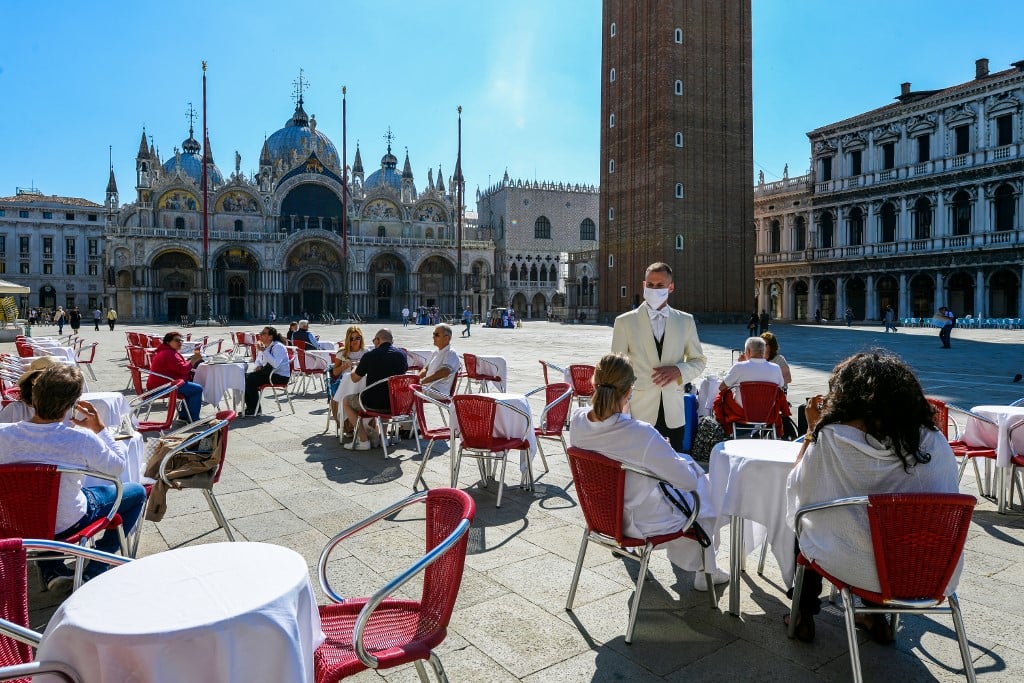Italy’s tourist numbers are booming, sparking hopes that the industry could see a return to something not far off pre-pandemic levels by the summer.
There’s just one catch: once again, as in past years, there aren’t nearly enough workers signing up for seasonal jobs this year to supply all that demand.
READ ALSO: Will tourism in Italy return to pre-pandemic levels this year?
“There’s a 20 percent staff shortage, the situation is dramatic,” Fulvio Griffa, president of the Italian tourist operators federation Fiepet Confesercenti, told the Repubblica newspaper.
Estimates for how many workers Italy is missing this season range from 70,000 (the figure given by the small and medium enterprise federation Conflavoro PMI) to 300-350,000 (the most recent estimate from Tourism Minister Massimo Garavaglia, who last month quoted 250,000).
Whatever the exact number is, everyone agrees: it’s a big problem.
Italy isn’t the only European country facing this issue. France is also short an estimated 300,000 seasonal workers this year. Spain is down 50,000 waiters, and Austria is missing 15,000 hired hands across its food and tourism sectors.
Italy’s economy, however, is particularly dependent on tourism. If the job vacancies can’t be filled and resorts are unable to meet the demand anticipated this summer, the country stands to lose an estimated €6.5 billion.

“After two years of pandemic, it would be a sensational joke to miss out on a summer season that is expected to recover strongly due to the absence of workers,” said Vittorio Messina, president of the Assoturismo Confesercenti tourist association.
Different political factions disagree as to exactly what (and who) is to blame for the lack of interest from applicants.
Italy’s tourism minister Massimo Garavaglia, a member of the right wing League party, has singled out the reddito di cittadinanza, or ‘citizen’s income’ social security benefit introduced by the populist Five Star Movement in 2019 for making unemployment preferable to insecure, underpaid seasonal work.
Bernabò Bocca, the president of the hoteliers association Federalberghi, agrees with him – along with large numbers of small business owners.
“What’s going to make an unemployed person come to me for 1,300 euros a month if he can stay sprawled on the beach and live off the damned citizenship income?” complained an anonymous restauranteur interviewed by the Corriere della Sera news daily.
“Before Covid, I had a stack of resumes this high on my desk in April. Now I’m forced to check emails every ten minutes hoping someone will come forward. Nothing like this had ever happened to me.”
READ ALSO: MAP: The best Italian villages to visit this year

Five Star MPs, however, argue that the focus on the unemployment benefit is a distraction from the real issues of job insecurity and irregular contracts.
There appears to be some merit to that theory. A recent survey of 1,650 seasonal workers found that only 3 percent of the people who didn’t work in the 2021 tourist season opted out due to the reddito di cittadinza.
In fact the majority (75 percent) of respondents who ended up not working over the 2021 season said they had searched for jobs but couldn’t find any openings because the Covid situation had made it too uncertain for companies to hire in advance.
READ ALSO: MAP: Which regions of Italy have the most Blue Flag beaches?
Others said the most of jobs that were advertised were only for a 2-3 month duration, half the length of the season (again, due to Covid uncertainty), making it not worth their while to relocate.
Giancarlo Banchieri, a hotelier who is also president of the Confesercenti business federation, agrees that Covid has been the main factor in pushing workers away from the industry, highlighting “the sense of precariousness that this job has taken on in the last two years: many people have abandoned it for fear of the uncertainty of a sector that has experienced a terrible time.”

“I said goodbye to at least seven employees, and none of them are sitting at home on the citizen’s income,” Banchieri told Repubblica.
“They have all reinvented themselves elsewhere; some are plumbers, others work in the municipality.”
READ ALSO: OPINION: Mass tourism is back in Italy – but the way we travel is changing
To counteract the problem, Garavaglia has proposed three measures: increasing the numbers of visas available for seasonal workers coming from abroad; allowing people to work in summer jobs while continuing to receive 50 percent of their citizen’s income; and reintroducing a voucher system that allows casual workers to receive the same kinds of welfare and social security benefits as those on more formal contracts.
Whether these will be enough to save Italy’s 2022 tourist season remains to be seen, but at this stage industry operators will take whatever fixes are offered.
“The sector is in such a dire situation that any common-sense proposals much be welcomed,” the Federalberghi president Bocca told journalists.



 Please whitelist us to continue reading.
Please whitelist us to continue reading.
They could also pay their employees better. One would think that waitstaff/retail workers on the Amalfi coast should make at least 3000 euros/month (which is still not that much). Enough to live on in a fairly expensive area, and still have some money for the off-season months. The reality is they make about 1000 euros/month, which is ridiculously low.
Given the relatively low food costs, the income for these businesses has to be going to rent, taxes, insurance, or the owners’ profits, all of which are legitimate. That said, if the owner’s are still able to make a good profit while paying their people a decent wage, then they should do so.
In one sentence of the article I read… “Italy’s economy, however, is particularly dependent on tourism. If the job vacancies can’t be filled and resorts are unable to meet the demand anticipated this summer, the country stands to lose an estimated €6.5 billion.”
Then I read…“What’s going to make an unemployed person come to me for 1,300 euros a month if he can stay sprawled on the beach and live off the damned citizenship income?” complained an anonymous restauranteur interviewed by the Corriere della Sera news daily.
Note to the ownership of these resorts…perhaps if you pay people a living respectable wage from that potential €6.5 billion, they might come and work for you. But you answered your own question…who is going to come off the beach for €1300 a month. NO ONE! Because NO ONE can survive on a ridiculously low wage. It’s that simple!!